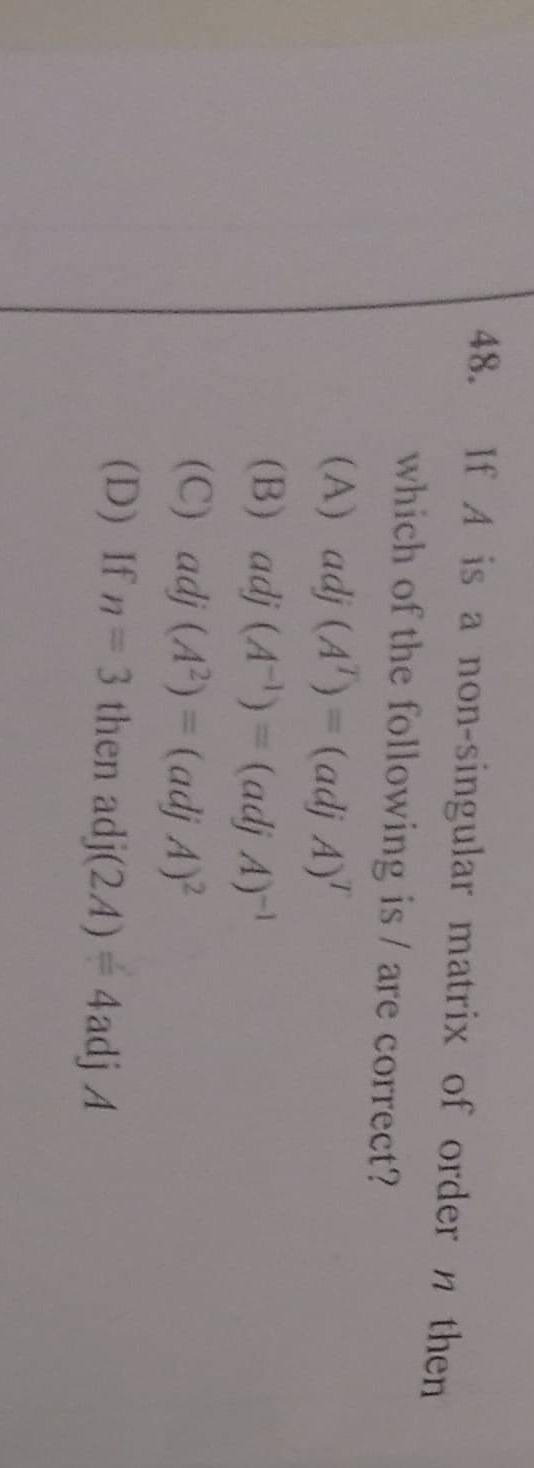Question
Question: If A is a non-singular matrix of order n then which of the following is / are correct?...
If A is a non-singular matrix of order n then which of the following is / are correct?

adj (AT) = (adj A)T
adj (A−1) = (adj A)−1
adj (A2) = (adj A)2
If n = 3 then adj(2A) = 4adj A
A, B, C, D
Solution
The problem asks us to identify the correct properties of the adjoint of a non-singular matrix A of order n. We will check each option using the fundamental properties of determinants, inverses, and adjoints.
Key properties of adjoint matrix:
- For any square matrix A, A⋅adj(A)=adj(A)⋅A=∣A∣In, where ∣A∣ is the determinant of A and In is the identity matrix of order n.
- If A is non-singular (i.e., ∣A∣=0), then A−1=∣A∣1adj(A). From this, we can also write adj(A)=∣A∣A−1.
Let's analyze each option:
(A) adj (AT) = (adj A)T We use the property adj(X)=∣X∣X−1. LHS: adj(AT)=∣AT∣(AT)−1. Since ∣AT∣=∣A∣ and (AT)−1=(A−1)T, adj(AT)=∣A∣(A−1)T.
RHS: (adj A)T=(∣A∣A−1)T. Using the property (kM)T=kMT for a scalar k and matrix M, (adj A)T=∣A∣(A−1)T.
Since LHS = RHS, option (A) is correct.
(B) adj (A−1) = (adj A)−1 We use the property adj(X)=∣X∣X−1. LHS: adj(A−1)=∣A−1∣(A−1)−1. Since ∣A−1∣=∣A∣1 and (A−1)−1=A, adj(A−1)=∣A∣1A.
RHS: (adj A)−1=(∣A∣A−1)−1. Using the property (kM)−1=k1M−1 for a scalar k and matrix M, (adj A)−1=∣A∣1(A−1)−1=∣A∣1A.
Since LHS = RHS, option (B) is correct.
(C) adj (A2) = (adj A)2 We use the property adj(X)=∣X∣X−1. LHS: adj(A2)=∣A2∣(A2)−1. Since ∣A2∣=∣A⋅A∣=∣A∣∣A∣=∣A∣2 and (A2)−1=(A⋅A)−1=A−1A−1=(A−1)2, adj(A2)=∣A∣2(A−1)2.
RHS: (adj A)2=(∣A∣A−1)2. (∣A∣A−1)2=(∣A∣A−1)(∣A∣A−1)=∣A∣2(A−1A−1)=∣A∣2(A−1)2.
Since LHS = RHS, option (C) is correct. Alternatively, we can use the property adj(XY)=adj(Y)adj(X). For X=A and Y=A, we get adj(A⋅A)=adj(A)adj(A), which means adj(A2)=(adj A)2.
(D) If n = 3 then adj(2A) = 4adj A We use the general property adj(kA)=kn−1adj(A), where n is the order of the matrix. In this option, k=2 and n=3. So, adj(2A)=23−1adj(A)=22adj(A)=4adj(A).
This property is correct.
Since all four options (A), (B), (C), and (D) are correct, this is a multiple correct options question.
